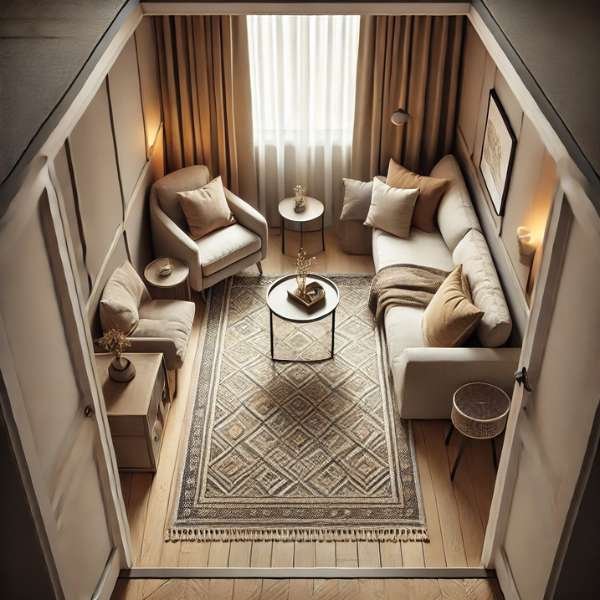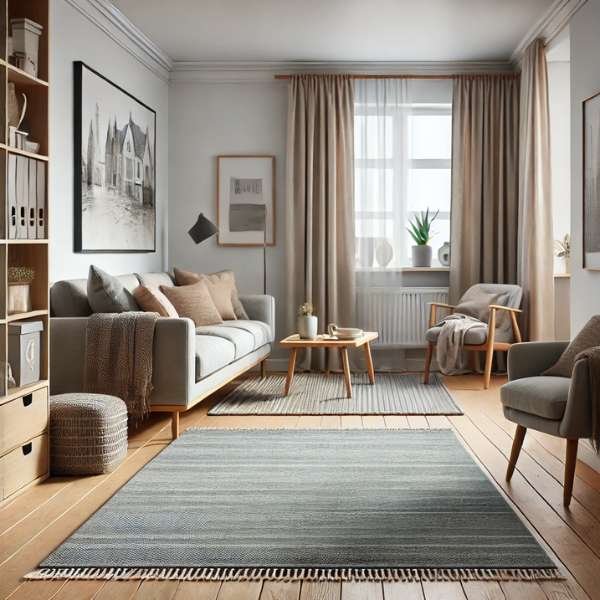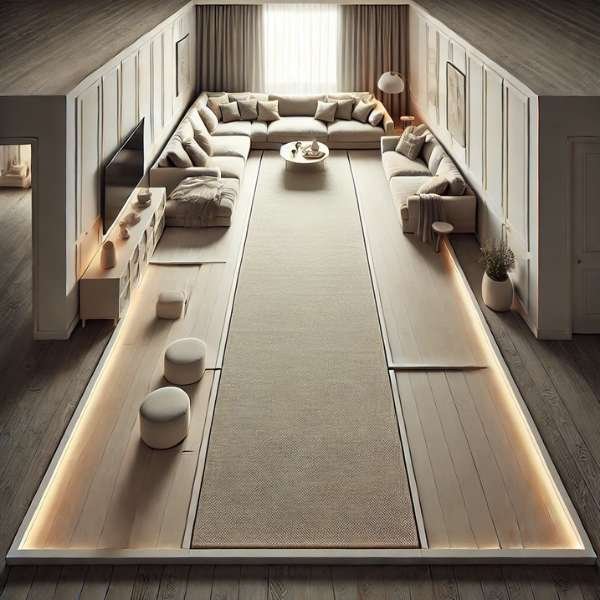Place a rug in a small Living room can immediately remodel the distance, including warm temperature, texture, and an experience of coziness. However, in compact areas, deciding on the right rug length and positioning it efficaciously requires a cautious idea. The proper rug now not the handiest enhances the room’s aesthetics however additionally makes the distance seem large and more cohesive. In this manual, we are able to discover how to locate a carpet in a small dwelling room to attain precise stability between style and capability. From length choice to format suggestions, we’ll assist you in creating a stunning look without overwhelming your area.
Why Rug Placement Matters in a Small Living Room

In small living rooms, every design decision carries extra weight. There’s little room (literally) for errors. The way you place your rug can influence the flow of the space, create visual balance, and optimize functionality. If your mat is too small or awkwardly placed, it can make the entire space feel disjointed or even more cramped than it already is. But with the right placement, you can anchor the furniture, create defined areas, and establish harmony within your living space.
How Rug Placement Transforms Your Space

An expertly placed rug can work wonders in a small sitting room. It pulls the space together, makes the space feel more cohesive, and even adds comfort. Whether you want a cozy nook or want to create the illusion of a bigger room, the strategic positioning of your mat can achieve the desired effect. The right placement can trick the eye, making your living space feel more expansive or intimate, depending on what vibe you’re going for.
Choosing the Perfect Rug Size
How to Measure Your Living Room for the Right Rug Size

Before you dive into the world of rugs, the first step is grabbing your tape measure. Know the exact dimensions of the floor space you want to cover. In small rooms, a mat that’s too large can overpower the space, while one that’s too small will make the space feel disconnected. Ideally, the mat should be large enough to sit under the front legs of all the major furniture pieces, creating a sense of unity.
To keep rug corners down on hardwood floors, ensure you choose the right size by measuring your living room carefully. Measure the seating area, leaving 8-12 inches of floor visible around the rug’s perimeter. A properly sized rug prevents excessive movement, minimizing curled edges. Anchoring the rug with furniture can further help keep corners flat and secure.
Common Rug Sizes That Work Best in Small Spaces

For small living rooms, popular rug sizes like 5×8 or 6×9 often do the trick. These sizes provide ample insurance without overwhelming the space. If you have a totally compact space, a 4×6 mat underneath your coffee table can be the sweet spot, leaving enough exposed floor to maintain a feel of openness.
How to Balance the Rug Size with Furniture Placement

Balancing rug size with furnishings is key. A common trick is to vicinity simplest the the front legs of your couch or chairs on the mat, leaving the back legs off. This method ties the furnishings together without crowding the space, placing an excellent stability among coverage and openness.
Understanding the Layout of Your Small Living Room
How to Assess Your Living Room’s Shape and Layout

Before setting your rug, take a top-notch study of your room. Is it square, square, or an odd form? Understanding the layout will guide your mat placement. You need the mat to decorate the room’s herbal form, now not disrupt its flow. The right placement will paintings with your room’s proportions, helping to create stability and harmony.
Using a Rug to Define Zones in Open-Plan Living Rooms

In open-plan residing areas, rugs can help separate regions for special sports activities. For instance, you can use a mat to define the seating vicinity, awesome from the eating or workspace. This zoning provides each functionality and style for your small residing space, giving it an extra organized, cohesive sense.
The Best Rug Placement for Corner Sofas in Small Spaces

For an L-formed or nook couch, the rug should increase barely past the sofa’s edges to help anchor the seating area. This placement guarantees a balanced appearance and forestalls the room from feeling disjointed. Grounding the sofa with the mat turns it right into a unifying detail, tying the whole lot collectively and growing a more organized and cohesive vicinity.
Centering Your Rug for Maximum Impact
How to Center a Rug Under a Coffee Table for a Cohesive Look

A carpet targeted beneath an espresso desk does more than look neat—it pulls the whole room into concord. Position it in order that there’s the same amount of mat extending across the table. This attracts attention to the center of the space, giving it a unified, grounded appearance. Suddenly, your area feels more intentional.
The Importance of Symmetry: Balancing Your Rug with Furniture

Symmetry is essential in small residing rooms. If your mat is centered effectively, the rest of the furniture certainly follows fit, growing a balanced and harmonious layout. Symmetry brings an experience of calm and order, making your small residing space experience open, prepared, and aesthetically appealing.
Rug Placement Ideas for Different Seating Arrangements
Best Rug Placement for Sectional Sofas in Small Living Rooms

For sectional sofas, extend the mat just beyond the seating area. This anchors the furniture and helps define the space without creating unnecessary clutter. The mat should be large enough to encompass the sofa’s dimensions but not so large that it engulfs the space.
How to Place a Rug Under a Floating Sofa

For a sofa positioned away from the wall, often called a floating sofa, the mat should extend 6 to 12 inches beyond the front edge. This placement anchors the furniture in the center of the room, establishing a visually balanced and appealing layout that enhances the overall space.
When to Place a Rug Only Partially Under Furniture

In smaller spaces, you don’t always need the mat to fully support your furniture. Placing it only partially under key pieces, like the front legs of the sofa, can create the illusion of more space while still tying the room together. This technique opens up the space without sacrificing coziness.
Creating Visual Space with the Right Rug Color and Pattern
Choosing a Rug Color to Make Your Small Living Room Feel Bigger

The right color can make all the difference. Lighter-colored mats—think soft grays, ivories, or beige—reflect light and open up the space, creating the illusion of a larger room. Darker mats, while stylish, tend to absorb light and can make a small space feel even smaller.
How Patterns Can Enhance or Detract from a Small Living Room

Patterns are tricky. Done right, they add character and depth. Subtle, understated geometric or floral patterns can bring visual interest to a small space without overwhelming it. But be careful—large, bold patterns might make the room feel cluttered and chaotic.
Rug Materials That Work Best in Small Living Rooms
Low-Pile vs. High-Pile: Which Rug Material Is Best for Small Spaces?

In small spaces, low-pile carpets are the top-rated choice. They provide a swish, clean look and are less difficult to hold. While excessive-pile mats provide coziness, they could make the space experience greater cramped and upload useless bulk. Choosing low-pile materials facilitates keeping both practicality and style in compact dwelling areas.
How to Choose Durable, Easy-to-Clean Rugs for High-Traffic Areas

Small sitting rooms often see heavy foot traffic, so choosing a durable, easy-to-clean mat is a must. Materials like wool or synthetic blends are both stylish and functional, offering longevity and stain resistance. You want a mat that can handle everyday wear and tear without losing its aesthetic appeal.
Layering Rugs for Added Texture and Depth
How to Layer Rugs to Add Dimension in a Small Living Room

Layering carpets can add size to a small sitting room, growing a feel of depth and complexity. Start with an impartial base mat and layer a smaller, extra textured, or patterned mat on the pinnacle. This technique adds warmth and hobby to the space without making it feel overcrowded.
Choosing the Right Size for an Accent Rug on Top of a Larger Rug

To attain a balanced look whilst layering carpets, make sure the top mat is especially smaller than the base mat but still huge enough to face out. This method adds intensity to your layout whilst preserving proper proportions in the space.
Making the Most of Oddly-Shaped Living Rooms
How to Use a Round Rug to Soften a Small, Angular Space

In rooms with sharp angles or unusual layouts, a spherical carpet can soften the gap. The round shape contrasts with the immediate strains of your furniture, including a sense of float that complements the room’s normal design. Round mats can be particularly powerful in creating focal factors in oddly formed rooms.
Placing a Rug in a Narrow or L-Shaped Living Room: Tips and Tricks

In slim or L-formed dwelling rooms, a protracted, square mat can assist elongate the distance, making it experience more cohesive. This placement visually connects unique regions of the space, decreasing the segmented feel and giving the space a greater prepared drift.
conclusion
In placing a mat in a small sitting room, simplicity frequently ends in pleasant outcomes. The right mat size, color, and texture can decorate the gap without overpowering it. Prioritize balance and symmetry to create a cohesive, harmonious experience, and do not hesitate to experiment with layering or specific substances to add depth and interest. If your space begins to feel stagnant, absolutely converting the placement of your mat could make all the difference. Sometimes, a small adjustment is all it takes to refresh and revitalize the whole space, proving the strength of this frequently underestimated design element.

